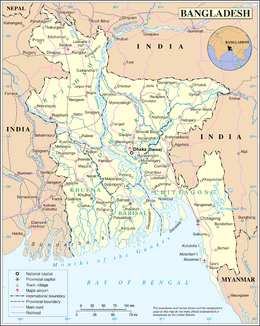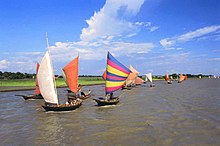| Revision as of 17:54, 24 January 2018 editMiniapolis (talk | contribs)Edit filter managers, Autopatrolled, Administrators71,974 edits →Road: Partial ce← Previous edit | Revision as of 18:16, 24 January 2018 edit undoMiniapolis (talk | contribs)Edit filter managers, Autopatrolled, Administrators71,974 edits →Traffic jams: CeNext edit → | ||
| Line 30: | Line 30: | ||
| Prime Minister ] inaugurated Bangladesh's highest road, Thanchi-Alikadam Road in ], in a 2015 video conference from Dhaka. Construction of The road, which is {{convert|2500|ft}} above sea level, was built under army supervision at a cost of {{lang|bn|৳}}1.17 billion and is aiding development, education and health in the hill tracts. | Prime Minister ] inaugurated Bangladesh's highest road, Thanchi-Alikadam Road in ], in a 2015 video conference from Dhaka. Construction of The road, which is {{convert|2500|ft}} above sea level, was built under army supervision at a cost of {{lang|bn|৳}}1.17 billion and is aiding development, education and health in the hill tracts. | ||
| === Traffic jams === | === {{anchor|Traffic jams}}Traffic congestion === | ||
| With more than {{formatnum:250000}} vehicles in Bangladesh and |
With more than {{formatnum:250000}} vehicles in Bangladesh and the country's population and infrastructure, ] wastes fuel and time and makes travel difficult. It also makes existing public transport inefficient, adding unsafe levels of noise and air pollution. Noise and pollution are stressful, and lead to medical conditions such as ] and ]. | ||
| Traffic congestion |
Traffic congestion varies during the day, necessitating planning and longer trips; this impacts productivity, cutting across social and economic status. Although walking is a major travel mode of the low-income majority, pedestrian needs are ignored in transport planning. As a result of traffic congestion, more people walk and bicycle; however, both may be dangerous. Almost 80 percent of traffic fatalities in Dhaka are pedestrians struck by a fuel-based vehicle.<ref>{{cite web | url=http://www.lkwankauf.org/lkw-verkaufen/ | title=Lkw verkaufen from Germany | accessdate=5 May 2015}}</ref> Although private cars are four percent of total vehicles, they occupy about 70 percent of road space. Public transport must be stressed in any future policy. The change to ] (CNG) cars saved over 4,000 premature deaths in 2009, but their low cost has increased the number of cars on the roads (although CNG price increases may have tempered the increase) and decreased the amount of natural gas available for other purposes.<ref>{{Harvnb|Sunny|2011|p=234}}</ref> | ||
| == Rail == | == Rail == | ||
Revision as of 18:16, 24 January 2018

Transport is an important part of Bangladesh's economy. Since the liberation of the country, the development of infrastructure has progressed rapidly and a number of land, water and air transport modes exist. However, significant progress must be made to ensure uniform access to all available transport. Unlike other nations, Bangladesh has four ministries responsible for transportation in the country:
- Road safety – Ministry of Road Transport and Bridges
- Rail transport – Ministry of Railways (Bangladesh)
- Civil aviation – Ministry of Civil Aviation and Tourism
- Maritime transport – Ministry of Shipping (Bangladesh)
The Ministry of Road Transport and Bridges has two divisions: Bridges and Road Transport and Highways.
Road
See also: List of roads in Bangladesh Two motorcycles rounding a curveThe 33-kilometre (21 mi) Thanchi-Alikadam Road via Dim paharFive motorbikesMotorbikes on the roadWith continued economic development, Dhaka (Bangladesh's capital) is beginning to experience severe traffic congestion. This is impacting the quality of life for inhabitants of the metropolitan area, the nation's largest. Many government and public-transport agencies drafted policies, undertook projects and implemented programmes to solve the problem. The Dhaka Integrated Transport Studies, conducted by the Ministry of Planning in 1991–1994, found that the uncoordinated activities of Dhaka City Corporation (DCC), Rajdhani Unnayan Kartripakkha (RAJUK) and the Bangladesh Road Transport Authority (BRTA) did not alleviate the problem and there was no one organisation responsible for improving the city's transport and traffic problems.
With financial assistance from the World Bank, the government of Bangladesh created the Dhaka Transport Coordination Board in 1998. An urban transport plan was commissioned with the US consultant Louis Berger Group and Bangladesh Consultant Ltd (BCL). Introduced in 2008, the comprehensive transport plan for the Greater Dhaka City and its adjoining areas (such as Tongi, Gazipur, Savar, Narayanganj, Keraniganj, Narshingdi and Manikganj) covered around 1,530 square miles (4,000 km). The plan looked at 15 key policy issues, including safety, pedestrian preferences, public transport, non-motorised transport, travel demand management and mass transit systems, and almost 70 policy recommendations were made. Ten comprehensive transport strategies were evaluated, using a baseline of no Bus rapid transit (BRT) or metro service, and a number of alternatives were explored. The adopted plan included roads, a three-line Mass Rapid Transit (MRT) and three-line BRT. It included provisions for 54 new roads in and around the city, three-part elevated expressways and a circular waterway programme.
Prime Minister Sheikh Hasina inaugurated Bangladesh's highest road, Thanchi-Alikadam Road in Bandarban District, in a 2015 video conference from Dhaka. Construction of The road, which is 2,500 feet (760 m) above sea level, was built under army supervision at a cost of ৳1.17 billion and is aiding development, education and health in the hill tracts.
Traffic congestion
With more than 250,000 vehicles in Bangladesh and the country's population and infrastructure, traffic congestion wastes fuel and time and makes travel difficult. It also makes existing public transport inefficient, adding unsafe levels of noise and air pollution. Noise and pollution are stressful, and lead to medical conditions such as cardiovascular disease and hypertension.
Traffic congestion varies during the day, necessitating planning and longer trips; this impacts productivity, cutting across social and economic status. Although walking is a major travel mode of the low-income majority, pedestrian needs are ignored in transport planning. As a result of traffic congestion, more people walk and bicycle; however, both may be dangerous. Almost 80 percent of traffic fatalities in Dhaka are pedestrians struck by a fuel-based vehicle. Although private cars are four percent of total vehicles, they occupy about 70 percent of road space. Public transport must be stressed in any future policy. The change to compressed natural gas (CNG) cars saved over 4,000 premature deaths in 2009, but their low cost has increased the number of cars on the roads (although CNG price increases may have tempered the increase) and decreased the amount of natural gas available for other purposes.
Rail
Main article: Bangladesh Railway

Railway acts as an important method of mass transport in Bangladesh. Many districts of the country are connected via railways. Bangladesh Railway was mostly inherited from the British-established Assam Bengal Railway system after the partition of India in 1947. Bangladesh Railway's headquarters are located in the southern port city of Chittagong, which had historically been the south-eastern terminus of the Assam Bengal Railway. After independence from West Pakistan in 1971, only a small length of new tracks were laid out.
As of 2005, the total length of railway is 2,706 kilometres (1,681 mi). Of that, 923 km (574 mi) are broad gauge (1,676mm) tracks (mostly in the western region), and the remaining 1,822 km (1,132 mi) are metre gauge tracks (mostly in the central and eastern regions). The gauge problem is being addressed by adding third rails to the most important broad and metre gauge routes, so that they become dual gauge.
A major road-railway bridge over the Jamuna River opened in 1998 to connect the previously isolated east and west railway networks.
The border between India and Bangladesh cuts across railway lines, forcing them into the other country for short distances. This complicates border controls such as passport validation.
After 43 years, the train transportation system between Bangladesh and India reopened on 2008 via Maitree Express. In 2017, the second service was inaugurated.
Air
Airlines
Main article: List of airlines of BangladeshBiman Bangladesh Airlines is the national airlines of Bangladesh which commenced operation in 1972. The other Bangladeshi registered passenger airlines are NovoAir, Regent Airways and United Airways. All four of these airlines have a hub at Hazrat Shahjalal International Airport in Dhaka and operate both domestic and international flights.
Airports
Main article: List of airports in BangladeshThere are currently three international airports in Bangladesh: Shahjalal International Airport in Dhaka, Shah Amanat International Airport in Chittagong and Osmani International Airport in Sylhet. All three international airports have direct connections to a number of destinations in the Middle East while Hazrat Shahjalal International Airport has services to the wider Asian region and Europe. In addition to the international airports there are also five domestic airports in Barisal, Cox's Bazar, Jessore, Rajshahi and Saidpur with almost all services from these airports either bound for or originating from Dhaka.
Water


There are 5,150–8,046 km (3,200–5,000 mi) of navigable waterways (includes 2,575–3,058 km or 1,600–1,900 mi of main cargo routes).
Because of Bangladesh's many rivers, ferries are a major form of transport. These ferries are notoriously dangerous. They are often overloaded, and they continue to operate during rough weather. Hundreds of people die each year in ferry and launch accidents. In 2016, a launch called Pinak 6 sank with more than 200 passengers on board near Munshiganj's Louhajang Upazila in river Padma. Many types of boats are also used for transport.
Ports and harbours
- Chittagong; Port of Chittagong; Chittagong Port Authority – east coast
- Dhaka – River port
- Mongla Port
- Sonadia – proposed
- Payra U/C
- Narayanganj-River port
- Baghabari- River port
- Ashuganj- River port
Merchant marine
Portal:Nautical/Fleet/Bangladesh
Pipelines
As of 2013 Bangladesh has approximately 2,950 km of natural gas pipelines.
References
- "Baumaschine Ankauf germany provides to Bangladesh". LKW Ankauf. Retrieved 5 May 2015.
- Sunny 2011, p. 9
- "Lkw verkaufen from Germany". Retrieved 5 May 2015.
- Sunny 2011, p. 234
- Bangladesh Transport Website FAQ
- "Pinak 6 accident in Bangladesh".
- https://www.cia.gov/library/publications/the-world-factbook/geos/bg.html. CIA World Factbook. 2013
- "Aristocrat Pokies Australia". Retrieved 10 June 2015.
Notes
- Sunny, Sanwar (2011). Green Buildings, Clean Transport and the Low Carbon Economy: Towards Bangladesh's Vision of a Greener Tomorrow. Germany: LAP Publishers. ISBN 978-3-8465-9333-2.
![]() This article incorporates public domain material from The World Factbook. CIA.
This article incorporates public domain material from The World Factbook. CIA.
External links
| Bangladesh articles | |||||||||||||||
|---|---|---|---|---|---|---|---|---|---|---|---|---|---|---|---|
| History |
| ||||||||||||||
| Geography | |||||||||||||||
| Politics |
| ||||||||||||||
| Economy |
| ||||||||||||||
| Society |
| ||||||||||||||